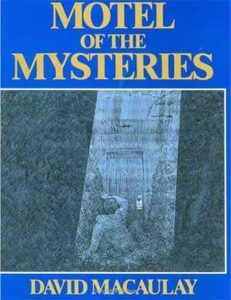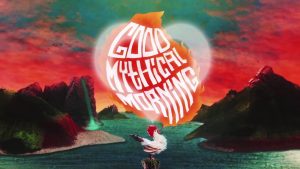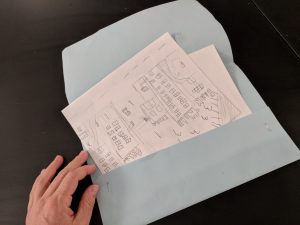Here are some of the teacher projects and ideas that we talked about tonight.
PROJECT SHARED: IDENTITY ARTIFACTS (Jenny Drake)

Jenny’s students investigate time and cultural artifacts. She first brought “a bunch of junk” from home and told the student that these artifacts were being curated by experts in Denver. They discussed the meaning and definition of “artifact.” Then they investigated Motels of the Mysteries by David Macaulay (PDF Summary). Students were challenged to make an artifact that represents who they are, so when someone 200 years from now comes along, those people will be able to use the artifact to learn who the student was. The challenge was to communicate their identity in an authentic way, so that their identity wouldn’t be misinterpreted 200 years from now. Students used different media, including soap carving.
JENNY’S QUESTION TO OUR GROUP AND THEIR RESPONSES: How can the ideation process be more robust for this project?
Ideation Exercise Idea: “Playful Excavation” Place obscure objects in a box of sand for student archeology groups to discover. From the mysterious artifact, students ask questions, infer meaning, and write a story about it.
Ideation Exercise Idea: Take an everyday object and answer the prompt: If someone found this 200 years from now, what would they think it was? A fun resource could be: Viral videos of children exploring cassette players.
Ideation Exercise Idea: Archeologists explore trash heaps. What is in our trash reveals our lives. It may be interesting to ask the question, if someone saw in your garbage, what would they find? What would it say about you? Could you do a garbage investigation in the school?
PROJECT SHARED: WHAT MAKES CULTURE? AND WHO DECIDES? (Laurie Edmonstone)

Everybody has a culture and even though sometimes seems like you don’t at first, it is there. Students started with a mind map. First of all what is a mind map. Tangent! The episode on mind mapping with Good Mythical Morning Youtubers…two dudes who do a show on really interesting stuff like, “Will it Shoe?…making shoes out of books, meatloaf, etc” or “Will it corndog?…hybridizing corndogs with other things, like sushi. Check them out.
We digress.
Back to the project. As students “mind-mapped” their culture, they researched what others say about their culture: What do the so-called experts have to say about their culture?, What does google images have to say about their culture?, etc.
Then they moved into personal identity, looking at artists who address identity in artworks: Alessandra Ross, Kip Omolad, etc. This project is just beginning.
PROJECT SHARED: ALTERED BODY (Jesse Bott)

Jesse’s 5th grade project integrates with human body curriculum from other classrooms. Students made body alterations based on the prompts, “If you could change anything about your body, what would you do? Would you alter your body for a belief? Enhance it for any particular reason?” Students brought their research about what they learned about our bodies and what they know about themselves. Students came up with alterations to run faster, jump higher, extend further, become a strength-protector, and morph into the natural world.
SKETCHFOLIOS
This led to a conversation about student sketch books. Because Jesse noticed that students needed to look at more than one research page at a time in their sketch books, he came up with a “sketchfolio.” This is basically a 17″x11″ piece of paper quarter-folded to make a pocket. Students make one sketchfolio per project to keep track of and access their process drawings and research.

INTEGRATION
That moved into a conversation about integration. What are the issues around this?
TIMING and TIME Do your schools give you time to collaborate with other disciplines or do they expect you to find the time on your own? There is a problem in the timing. Sometimes you find out what other teachers are doing and the collaboration is too late.
ART-TEACHER-IT-UP Educating your classroom teachers is an issue. What do you do when other classroom teachers want to collaborate but their idea for the “art project” is inauthentic and thin? You take the suggestion and then, as Jenny says, you art-teacher it up. Here are some examples from Jesse.
- Teachers requested an integration with a butterfly study. The art teacher bypassed the usual elementary school-art-style project and had students use their knowledge of butterflies and other insects to create hybridized new creatures. The 3D work was displayed in Mark Dion-esque boxes, like an old, natural history display.
- Teachers requested a multi-cultural art project e.g. Chinese Lanterns. The art teacher bypassed this offer and partnered with another teacher who was game to for students to create art based on a rich investigation in the symbols of their own culture and community.
CRAFT
This led to a conversation on beauty and craftsmanship. How do you show classroom teachers the lack of learning and the inauthenticity of a weak art project idea, while still honoring their need to have pretty artworks for the halls? What can art teachers do to help kids think deeply, yet still build media skills? How can you scaffold for smart student art work that is also beautiful?
DOCUMENTATION OF STUDENT THINKING
This led to a conversation on documentation of student thinking in the hall. One art teacher only shows process in the hall, no final products. Documentation as a Reggio Emilia practice shows the process along with the final product. How do you compose the documentation board in a way to shows both?
GETTING HIGH SCHOOL STUDENTS TO OWN THEIR RUBRIC CRITERIA
We swayed to a conversation about rubrics. Laurie shared how she gives students overarching categories like “idea” and “execution.” Then she tells students about the project and media and asks them, “How would you fail at them?” Students envision how they would fail. Together students and teacher created the “beginning” or low bar column for the rubric. From that bad list they move to the better work. “Let’s make the good end.” Finally after the basic criteria column is written, Laurie leaves the last “Exceeds Expectations” column blank, intending for students to fill that in if they think their finished work does exceed expectations, going beyond the minimum expectation. Written with students.
Another effective High School assessment strategy: Laurie posts the final grades of a project, omitting the students’ names. For instance: Period one’s ceramic project had 5 A’s, 9 B’s, 3 C’s, 5D’s. That way students can privately see where their performance is situated within the entire class score. This gives students confidence and reassurance as well as a wake up call.
FYI, Susan Brookhart is Anne’s go-to scholar when it comes to meaningful rubrics.
S. Brookhart Misconceptions about Rubrics
TEACHING ABROAD!
Laurie sold her house and is moving her family to China for two years to teach art in Shanghia via Teaching Nomad. If you have questions about international teaching, reach out to Laurie via the TLP email group.

Finally….over Thanksgiving break, go see the Tara Donavan show at MCA! Several teachers tonight raved about it.
See you in January!
